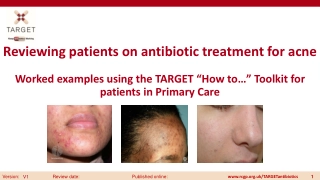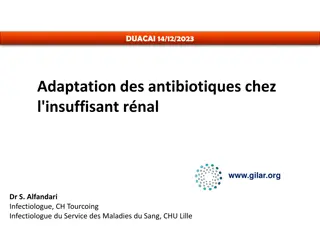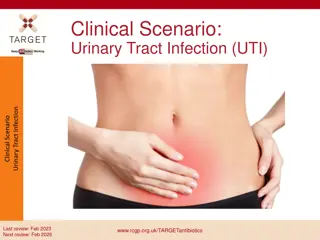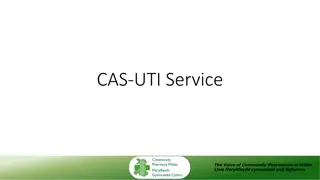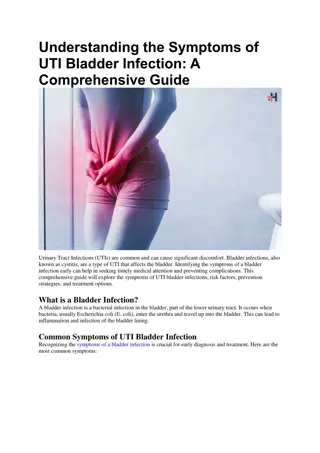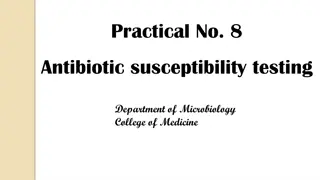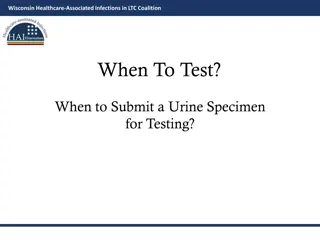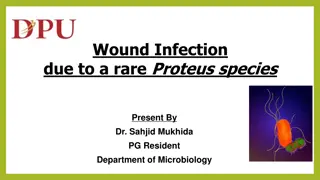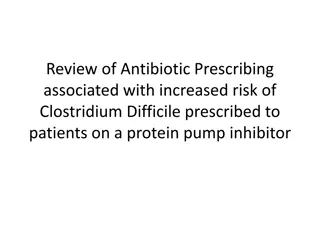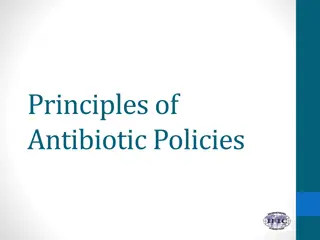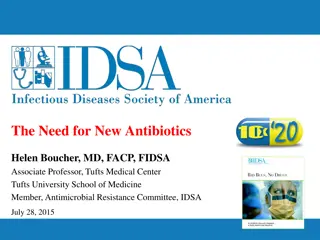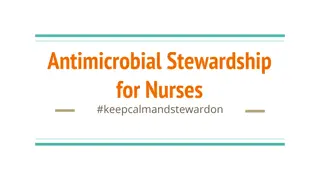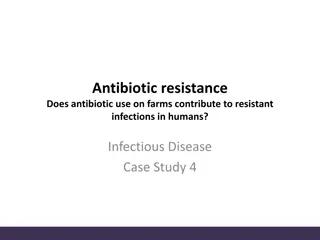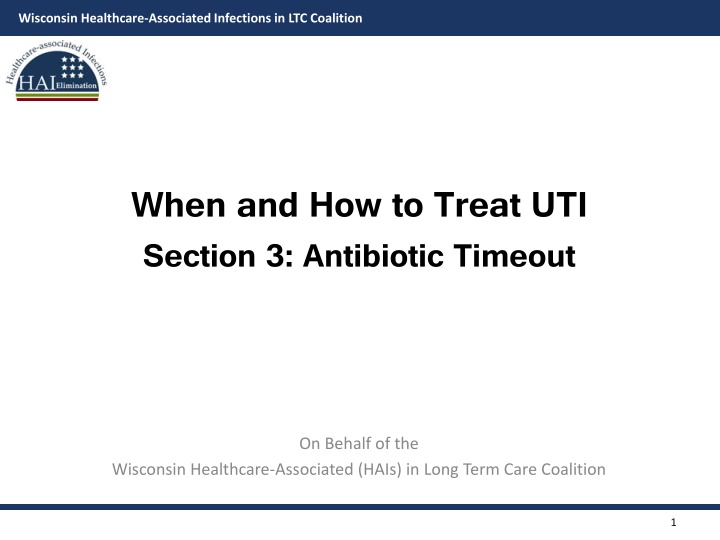
Wisconsin Healthcare-Associated Infections: UTI Treatment and Antibiotic Timeout Guide
Explore guidelines for treating urinary tract infections (UTIs) in long-term care facilities through the Wisconsin Healthcare-Associated Infections in LTC Coalition. Learn about the importance of antibiotic timeouts and when to reassess antibiotic therapy. Gain insights on modifying existing antibiotic regimens for better outcomes and resident care.
Download Presentation

Please find below an Image/Link to download the presentation.
The content on the website is provided AS IS for your information and personal use only. It may not be sold, licensed, or shared on other websites without obtaining consent from the author. If you encounter any issues during the download, it is possible that the publisher has removed the file from their server.
You are allowed to download the files provided on this website for personal or commercial use, subject to the condition that they are used lawfully. All files are the property of their respective owners.
The content on the website is provided AS IS for your information and personal use only. It may not be sold, licensed, or shared on other websites without obtaining consent from the author.
E N D
Presentation Transcript
Wisconsin Healthcare-Associated Infections in LTC Coalition When and How to Treat UTI Section 3: Antibiotic Timeout On Behalf of the Wisconsin Healthcare-Associated (HAIs) in Long Term Care Coalition 1
Wisconsin Healthcare-Associated Infections in LTC Coalition UTI Toolkit Module 4c Narration by: Christopher J. Crnich, MD PhD Chief of Medicine, William S. Middleton Memorial VA Hospital Associate Professor of Medicine, University of Wisconsin-Madison Content developed in partnership with the Wisconsin Healthcare-Associated Infections in Long-Term Care Coalition Funding for this project was provided by the Wisconsin Partnership Program at the UW School of Medicine and Public Health
Wisconsin Healthcare-Associated Infections in LTC Coalition There are Five Moments of Antibiotic Decision-Making Should I Test? 1 Should I Treat? 2 How do I Treat? 3 Should I Change/Modify? 4 How Long do I Treat? 5 3
Wisconsin Healthcare-Associated Infections in LTC Coalition Opportunities to Modify Existing Antibiotic Therapy in NHs Record review study of 364 residents being treated for UTI in 5 Wisconsin NHs Subject is being treated for UTI in a nursing home or emergency department setting Yes 2/3rds of the treatment courses amenable to some form or modification Subject does not meet McGeer or Loeb criteria OR Urine analysis and/or urine culture are negative No Discontinue Antibiotics. Yes Shorten and streamline 8 (2%) Stop, shorten, and streamline 8 (2%) Continue Antibiotics Stop and streamline 28 (8%) No intervention opportunity* 119 (34%) Subject receiving a fluoroquinolone AND Urine culture shows susceptibility to a narrow-spectrum alternative Duration of effective antibiotic therapy is > 7 days Stop and shorten 55 (16%) No Yes No Yes Streamline 20 (6%) Change to appropriate narrow- spectrum antibiotics Treatment duration is appropriate Shorten treatment duration No change needed Stop Shorten 15 (4%) 100 (28%) 12 Hossin et al. IDWeek 2017
Wisconsin Healthcare-Associated Infections in LTC Coalition What is an Antibiotic Timeout? A scheduled time for clinicians to re-evaluate the appropriateness of their resident s antibiotics. Typically performed 48-72 after starting antibiotic therapy and culture results (if obtained) are back. The CDC recommends this be done with every prescription, regardless of treatment location. Focus on the 3 S s (Stop, Spectrum, Shorten) 13 Lee et al. Ann Intern Med 2014 14 Jones et al. J Biomed Inform 2017 5
Wisconsin Healthcare-Associated Infections in LTC Coalition The 3 Ss of the Antibiotic Timeout Stop Spectrum Shorten 6
Wisconsin Healthcare-Associated Infections in LTC Coalition The 3 Ss of the Antibiotic Timeout If another explanation for resident change-in-condition identified If urine culture is negative Stop Spectrum Shorten 7
Wisconsin Healthcare-Associated Infections in LTC Coalition The 3 Ss of the Antibiotic Timeout Stop Change to an antibiotic with activity against organism recovered Resistance Spectrum Shorten 8
Wisconsin Healthcare-Associated Infections in LTC Coalition The 3 Ss of the Antibiotic Timeout Stop Change to an antibiotic with activity against organism recovered Resistance Spectrum De-escalate to narrow spectrum alternative (e.g., NFT, TMP/SMX) No Resistance Shorten 9
Wisconsin Healthcare-Associated Infections in LTC Coalition The 3 Ss of the Antibiotic Timeout Stop Spectrum Uncomplicated Females: 3-7 days Males: 7 days Shorten 10
Wisconsin Healthcare-Associated Infections in LTC Coalition The 3 Ss of the Antibiotic Timeout Stop Spectrum Uncomplicated Females: 3-7 days Males: 7 days Shorten TMP/SMX: 7-10 days Beta-lactams: 7-10 days Fluoroquinolones: 5-7 days Complicated 11
Wisconsin Healthcare-Associated Infections in LTC Coalition The 3 Ss of the Antibiotic Timeout If another explanation for resident change-in-condition identified If urine culture is negative Stop Change to an antibiotic with activity against organism recovered Resistance Spectrum De-escalate to narrow spectrum alternative (e.g., NFT, TMP/SMX) No Resistance Uncomplicated Females: 3-7 days Males: 7 days Shorten TMP/SMX: 7-10 days Beta-lactams: 7-10 days Fluoroquinolones: 5-7 days Complicated 12

